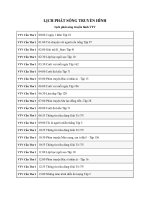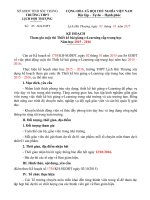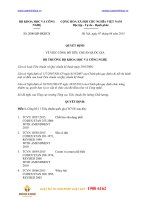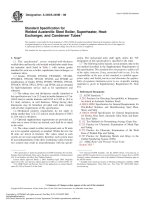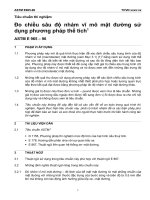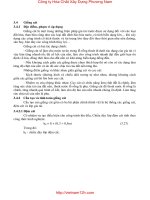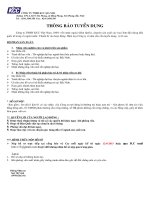Astm e 1127 08 (2015)
Bạn đang xem bản rút gọn của tài liệu. Xem và tải ngay bản đầy đủ của tài liệu tại đây (117.16 KB, 5 trang )
Designation: E1127 − 08 (Reapproved 2015)
Standard Guide for
Depth Profiling in Auger Electron Spectroscopy1
This standard is issued under the fixed designation E1127; the number immediately following the designation indicates the year of
original adoption or, in the case of revision, the year of last revision. A number in parentheses indicates the year of last reapproval. A
superscript epsilon (´) indicates an editorial change since the last revision or reapproval.
E1577 Guide for Reporting of Ion Beam Parameters Used in
Surface Analysis
E1634 Guide for Performing Sputter Crater Depth Measurements
E1636 Practice for Analytically Describing Depth-Profile
and Linescan-Profile Data by an Extended Logistic Function
E1829 Guide for Handling Specimens Prior to Surface
Analysis
2.2 ISO Standard:4
ISO/TR 22335: 2007 Surface Chemical Analysis—Depth
Profiling—Measurement of Sputtering Rate: MeshReplica Method Using a Mechanical Stylus Profilometer
1. Scope
1.1 This guide covers procedures used for depth profiling in
Auger electron spectroscopy.
1.2 Guidelines are given for depth profiling by the following:
Ion Sputtering
Angle Lapping and Cross-Sectioning
Mechanical Cratering
Mesh Replica Method
Nondestructive Depth Profiling
Section
6
7
8
9
10
1.3 The values stated in SI units are to be regarded as
standard. No other units of measurement are included in this
standard.
1.4 This standard does not purport to address all of the
safety problems, if any, associated with its use. It is the
responsibility of the user of this standard to establish appropriate safety and health practices and determine the applicability of regulatory limitations prior to use.
3. Terminology
3.1 Definitions:
3.1.1 For definitions of terms used in this guide, refer to
Terminology E673.
4. Summary of Guide
2. Referenced Documents
4.1 In ion sputtering, the surface layers are removed by ion
bombardment in conjunction with Auger analysis.
2.1 ASTM Standards:2
E673 Terminology Relating to Surface Analysis (Withdrawn
2012)3
E684 Practice for Approximate Determination of Current
Density of Large-Diameter Ion Beams for Sputter Depth
Profiling of Solid Surfaces (Withdrawn 2012)3
E827 Practice for Identifying Elements by the Peaks in
Auger Electron Spectroscopy
E996 Practice for Reporting Data in Auger Electron Spectroscopy and X-ray Photoelectron Spectroscopy
E1078 Guide for Specimen Preparation and Mounting in
Surface Analysis
4.2 In angle lapping, the surface is lapped or polished at a
small angle to improve the depth resolution as compared to a
cross section.
4.3 In mechanical cratering, a spherical or cylindrical crater
is created in the surface using a rotating ball or wheel. The
sloping sides of the crater are used to improve the depth
resolution as in angle lapping.
4.4 In nondestructive techniques, different methods of varying the electron information depth are involved.
5. Significance and Use
5.1 Auger electron spectroscopy yields information concerning the chemical and physical state of a solid surface in the
near surface region. Nondestructive depth profiling is limited
to this near surface region. Techniques for measuring the crater
depths and film thicknesses are given in (1).5
1
This guide is under the jurisdiction of ASTM Committee E42 on Surface
Analysisand is the direct responsibility of Subcommittee E42.03 on Auger Electron
Spectroscopy and X-Ray Photoelectron Spectroscopy.
Current edition approved June 1, 2015. Published June 2015. Originally
approved in 1986. Last previous edition approved in 2008 as E1127 – 08. DOI:
10.1520/E1127-08R15.
2
For referenced ASTM standards, visit the ASTM website, www.astm.org, or
contact ASTM Customer Service at For Annual Book of ASTM
Standards volume information, refer to the standard’s Document Summary page on
the ASTM website.
3
The last approved version of this historical standard is referenced on
www.astm.org.
4
Available from International Organization for Standardization (ISO), 1, ch. de
la Voie-Creuse, CP 56, CH-1211 Geneva 20, Switzerland, .
5
The boldface numbers in parentheses refer to a list of references at the end of
this standard.
Copyright © ASTM International, 100 Barr Harbor Drive, PO Box C700, West Conshohocken, PA 19428-2959. United States
1
E1127 − 08 (2015)
5.2 Ion sputtering is primarily used for depths of less than
the order of 1 µm.
determine if any of the Auger peaks have been displaced
outside of their analysis windows (6).
5.3 Angle lapping or mechanical cratering is primarily used
for depths greater than the order of 1 µm.
6.3 Crater-edge profiling of the sputter-formed crater by
using Auger line scans is a technique similar to the analysis of
the mechanically formed craters in Section 8 (7). Forming the
crater by sputtering may introduce the additional complications
of ion-induced damage and asymmetric crater dimensions.
5.4 The choice of depth profiling methods for investigating
an interface depends on surface roughness, interface
roughness, and film thickness (2).
6.4 If specimen rotation is used to reduce ion-induced
roughness, then the rotational speed, rotation axis runout
relative to ion beam sputtered area or wobble and data
acquisition rate should be reported (8, 9).
5.5 The depth profile interface widths can be measured
using a logistic function which is described in Practice E1636.
6. Ion Sputtering
6.1 The specimen should be handled in accordance with
Guides E1078 and E1829. First introduce the specimen into a
vacuum chamber equipped with an Auger analyzer and an ion
sputtering gun. Align the ion beam using a sputtering target or
a Faraday cup, paying careful attention to the relative spot size
of the electron beam, ion beam, and Faraday cup and their
respective orientations to ensure accurate convergence of the
two beams at the specimen surface.
6.1.1 Place the specimen in front of the Auger analyzer and
direct the ion gun towards the analysis area. If the ion beam is
not normal to the specimen surface then possible shadowing of
the analysis area from the ion beam, due to surface roughness,
must be considered. The ion beam conditions should be
reported in accordance with Guide E1577.
6.5 Identify the elements in the survey scans using Practice
E827.
6.6 The Auger data and the sputtering conditions should be
reported as described in Practice E996.
6.7 There is extensive information available in the literature
on the effects of ion bombardment on solid surfaces (10-15).
6.8 Special care must be exercised whenever specimen
temperature changes are present because effects due to surface
diffusion, surface segregation or diffusion limited bulk processes such as point defect migration can occur and dramatically alter the specimen composition, even over depths larger
than the ion beam penetration depth which is typically a few
nanometers (16, 17). The concept of preferential sputtering in
multielement, single-phase specimens has altered significantly
so that chemical effects such as surface segregation are
considered to be at least as important as physical effects such
as mass differences in the evolution of the near surface
composition during sputter depth profiling (18-21). Since the
probing depths in Auger electron spectroscopy are usually
smaller than the ion-penetration depth these effects are very
important in any interpretation of Auger signal intensity in
terms of composition during ion-beam profiling. Computer
modelling of these and other ion-induced phenomena has been
extensively studied and has provided new insights into this
field (22, 23).
6.8.1 It should be determined for each specimen if compositional changes or other sputter effects are likely to occur. It
may be possible to minimize these effects in some instances by
adjusting the sputtering parameters.
6.2 Choose the elements to be investigated from previous
experience or from an initial Auger electron spectrum or an
energy-dispersive X-ray spectrum since the latter spectrum can
reveal additional elements present at depths greater than those
that contribute to the Auger electron spectrum (3). Select a
specific transition for each element. During the depth profiling,
record the peak-to-peak heights for Auger derivative data, or
peak heights or peak areas for N(E) data. The data may be
gathered during continuous sputtering or between timed sputter
segments. Results may vary between the two techniques.
6.2.1 One source of their difference is due to the presence of
ion-induced electrons during continuous sputter depth
profiling, especially at low-electron kinetic energies, that can
become comparable in intensity to the electrons induced by the
probing incident electron beam. Unless one or the other of the
excitation beams is modulated and detected synchronously
these two types of emitted electrons are difficult to distinguish.
These ion-induced electrons usually form a featureless background that rises steeply as their kinetic energy decreases, but
sometimes ion-induced Auger peaks might be present whose
lineshape may be different from those produced by the electron
beam (4). As a result, care must be taken during continuous
sputtering to ensure reliable results. Another source of difference is due to the buildup of adsorbed species during the data
acquisition time in the discontinuous sputter depth profile
mode (5). If portions of the ion-eroded surface expose very
reactive phases, then Auger peaks due to adsorbed species, for
example, oxygen or carbon, or both, will appear in the spectra
and mask the actual depth distribution.
6.2.2 It is advisable when analyzing an unknown specimen
to periodically examine survey scans to detect any new
elements that were not present in the initial survey scan and to
6.9 Ion guns used in Auger analysis are normally selfcontained units capable of producing a focused beam of ions.
The specimen is not used as an anode for the gun. Many ion
guns are able to raster the ion beam. A rastered ion beam will
produce a more uniform ion current distribution on the
specimen surface in the region of analysis.
6.10 If the ion gun is differentially pumped, the vacuum
pumps may be left on during sputtering, removing most of the
sputtered gases. If not, then the chamber must be back filled
with gas and provisions for removing the sputtered active gases
must be considered. Titanium sublimation is effective in
removing these gases.
6.11 Noble gas ions are normally used in sputtering and the
most commonly used gas is argon. Xenon is occasionally used
2
E1127 − 08 (2015)
7.4 The depth resolution, ∆d, is given by the following
equation:
with high beam energies when rapid sputtering is needed.
Active gases such as oxygen and metal ions are used in special
circumstances.
6.11.1 Ion energies commonly used for depth profiling
using noble gases are in the range from 1 to 5 keV where lower
ion energies are usually preferred for improved depth resolution. Higher ion energies usually can be obtained with higher
ion currents and less preferential sputtering.
6.11.2 Ion beam current density can be measured by a
Faraday cup or by following Practice E684.
6.11.3 The sputter rate is needed to calibrate the depth scale
(24, 25, Guide E1634) when depth profiling using ion sputtering. Several reference standards are available for this purpose.
One reference material consists of 30 and 100-nm thick
tantalum pentoxide films (26).6 Another reference material is
an alternating nickel and chromium thin film structure; each
layer is nominally 50-nm thick.7
∆ d 5 ∆Ytanθ
where ∆Y includes the electron beam diameter and uncertainties in position that may be due to errors in specimen or
electron beam positioning.
7.5 Auger analysis can include line scans and point analysis
along the lapped surface. Perform the analysis by either
moving the specimen using micrometer adjustments or by
electronically moving the electron beam.
7.6 Ion sputtering (Section 6) is often used in conjunction
with angle lapping to remove contaminants and to investigate
interfaces beneath the lapped surfaces.
7.7 Consideration should be given if specimen mounting
methods, for example, plastic embedding media, are used
which may employ high vapor pressure materials. Out-gassing
of the media as well as trapped gases between the media and
the specimen may require complete removal of the mounting
materials prior to analysis.
7. Angle Lapping and Cross-Sectioning
7.1 In cross-sectioning, polish the specimen perpendicular
to the interface, while in angle lapping, polish the specimen at
an angle to increase the depth resolution as shown in Fig. 1
(27). Polishing usually includes the use of silicon carbide
papers, diamond paste, and alumina. Use progressively finer
polishing particles to obtain the desired surface finish. Possible
limitations of the techniques include smearing of material
across the interface, surface roughness, and the electron probe
diameter limiting the spatial resolution.
8. Mechanical Cratering
8.1 Ball Cratering:
8.1.1 First mount the specimen in a device where a rotating
steel ball can be placed against its surface. Commercial
apparatus is available that uses a rotating shaft with a notch that
holds the ball and spins it. The rotational speed and the force
against the specimen can be adjusted (28).
8.1.2 Coat the ball with an abrasive material to improve the
cratering rate. In practice diamond paste is used with a particle
size of 0.1 to 1 µm. The larger particle sizes will give the most
rapid cratering rates and the finer particle sizes will give the
smoothest crater wall surface. The coarser pastes can be used
first to form the crater and the fine pastes can be used to smooth
the crater wall. As with cross-sectioning and angle lapping,
consideration should be given to the possibility of smearing
material across the cratered surface.
8.1.3 The geometry of the crater is shown in Fig. 2. The
depth of the crater, d, is given by the following equation:
7.2 In angle lapping mount the specimen on a flat gage
block and measure the angle with a collimator. The accuracy
depends on the flatness of the specimen. In practice an angle of
0.1° can be accurately measured.
7.3 The depth, d, is given by the following equation:
d 5 Ytanθ
(2)
(1)
where (in Fig. 1) θ is the lapped angle and Y is the distance
from the edge.
6
Available from the National Physical Laboratory (NPL), Hampton Road,
Teddington, Middlesex, TW11 0LW, UK, . Listed as Certified
Reference Material NPL No. S7B83, BCR No. 261.
7
Available from National Institute of Standards and Technology (NIST), 100
Bureau Dr., Stop 1070, Gaithersburg, MD 20899-1070, . Listed
as NIST Standard Reference Material 2135.
d 5 D 2 /8R
NOTE 1—In practice, the angle θ is much smaller than shown, being of
the order of 1°.
(3)
FIG. 2 Cross Section of Specimen After Ball-Cratering Using a
Sphere of Radius, R, to a depth, d
FIG. 1 Cross Section of Angle-Lapped Specimen
3
E1127 − 08 (2015)
9.1.1 The Technical Report provides a method to convert
the ion-sputtering time scale to sputtered depth in a depth
profile by assuming a constant sputtering rate. It is not
applicable to the case where the sputtered area is less than 0.4
mm2 or where the sputter-induced surface roughness is significant compared with the sputtered depth to be measured (30).
where:
D = the diameter of the crater,
R = the radius of the ball, and
R = >> D/2.
8.1.4 The Auger analysis is the same as described in 7.5 and
7.6.
8.1.5 The depth at any point in the analysis, Z, is given by
the following equation (2):
Z 5 ~ R 2 2 x 2 1Dx 2 D 2 /4 ! 1/2 2 ~ R 2 2 D 2 /4 ! 1/2
10. Nondestructive Depth Profiling
10.1 Methods for nondestructive depth profiling with Auger
electron spectroscopy are based upon varying the effective
electron escape depth from the specimen and are limited to
characterizing the outermost 2 to 5 nm.
(4)
where x is the lateral distance from the crater edge. The
depth may also be given by the approximation as follows:
Z 5 x ~ D 2 x ! /2R
10.2 For certain elements, a depth dependence may be
found by examining Auger transitions of different energies
(31). The lower energy Auger electrons will have a shallower
escape depth than the more energetic electrons and therefore,
different transitions for the same element will have different
sampling depths.
(5)
8.1.6 The depth resolution, ∆Z, is given by the following
equation:
∆ Z 5 ∆xtanθ
(6)
where ∆x includes the electron beam diameter and other
uncertainties in lateral position and θ is the taper angle. In
contrast to angle lapping (Section 7), the taper angle, which is
defined as the angle between the surface and the tangent to the
crater, varies in value along the crater wall. Its value is given
by the following equation:
sin θ 5 ~ 0.5D 2 x ! 2/R
10.3 The sampling depth may also be varied to a limited
degree by varying the incident electron beam energy to
produce a weak depth dependence in the excitation volume of
the specimen (32).
10.4 Angle-resolved Auger electron spectroscopy, which
involves varying the collected take-off angle of the emitted
electrons, has been used for depth profiling (33), but the
technique is limited due to surface roughness and an often
observed angular anisotropy in the Auger signal strength
(34, 35).
(7)
The best resolution is when θ is the smallest at the crater
bottom.
8.2 Radial Sectioning—A technique similar to ball cratering
that uses a cylindrical grinding tool instead of a spherical one
(29).
10.5 A general formulation that incorporates electron-solid
interactions to characterize the low kinetic energy loss features
of an Auger peak can be inverted to produce a nondestructive
model depth profile within a depth of almost five times the
inelastic mean free path. The technique has been reported (36)
to be able to distinguish island growth from layer-by-layer
growth of adsorbed species.
9. Mesh Replica Method
9.1 ISO/TR 22335: 2007 describes a method for determining ion-sputtering rates for depth profiling measurements with
Auger electron spectroscopy (AES) where the specimen is
ion-sputtered over a region with an area between 0.4 mm2 and
3.0 mm2. The Technical Report is applicable only to a laterally
homogeneous bulk or single-layered material where the ionsputtering rate is determined from the sputtered depth, as
measured by a mechanical stylus profilometer, and sputtering
time.
11. Keywords
11.1 angle lapping; angle-resolved AES; Auger electron
spectroscopy; ball cratering; compositional depth profiling;
cross sectioning; depth profiling; depth resolution; sputter
depth profiling; sputtering; thin films
REFERENCES
Proceedings of the 7th International Vacuum Congress and 3rd
International Conference on Solid Surfaces, Vienna, 1977, pp.
2213–2216.
(4) Aizana, T., Tsuno, T., Daimon, H., and Ino, S., “Si (111) 7 × 7 and
Si(111) =3□3□ =3—Al Surface—Structure Analysis by Ioninduced Auger-Electron Spectroscopy,” Physical Review B, Vol 36, 1987,
pp. 9107–9114.
(1) International Standards Organization TR 15969 Surface Chemical
Analysis—Depth Profiling—Measurement of Sputtered Depth.
(2) Lea, C., and Seah, M. P., “Optimized Depth Resolution in IonSputtered and Lapped Compositional Profiles with Auger Electron
Spectroscopy,” Thin Solid Films, Vol 75, 1981, pp. 67–86.
(3) Kirschner, J., and Itzkorn, H., “Thin Film Analysis: from ‘Sputter
Profiles’ to ‘Depth Profiles’ by Combined Auger/X-ray Analysis,”
4
E1127 − 08 (2015)
(5) Holloway, P. H., and Stein, H. J., “Quantitative Detection of Oxygen
in Silicon Nitride on Silicon,” Journal of the Electrochemical Society,
Vol 123, 1976, pp. 723–728.
(6) Lea, C., “Composition-Depth Profiling Using Auger Electron
Spectroscopy,” Metal Science, Vol 17, 1983, pp. 357–367.
(7) Taylor, N. J., Johannessen, J. S., and Spicer, W. E., “Crater-Edge
Profiling in Interface Analysis Employing Ion-Beam Etching and
AES,” Applied Physics Letters, Vol 29, No. 8, 1976, pp. 497–499.
(8) Zalar, A., “Improved Depth Resolution by Sample Rotation During
Auger Electron Spectroscopy Depth Profiling,” Thin Solid Films, Vol
124, 1985, pp. 223–230.
(9) Geller, J. D., and Veisfeld, N., “Depth Resolution Improvements
Using Specimen Rotation During Depth Profiling,” Surface and
Interface Analysis, Vol 14, 1989, pp. 95–98.
(10) “Sputtering by Particle Bombardment I,” Topics in Applied Physics,
Ed. R. Behrisch, Vol 47, Springer, New York, 1981.
(11) “Sputtering by Particle Bombardment II,” Topics in Applied Physics,
Ed. R. Behrisch, Vol 52, Springer, New York, 1983.
(12) Bevolo, A. J., “Ion/Solid Interactions in Surface Analysis,” in
Characterization of Semiconductor Materials, Vol 1, Chapter 4, Ed.
G. E. McGuire, Noyes, New Jersey, 1989.
(13) Wittmaack, K., “Beam Induced Broadening Effects in Sputter Depth
Profiling,” Vacuum, Vol 34, 1984, pp. 119–137.
(14) “Thin Film and Depth Profile Analysis,” Topics in Current Physics,
Vol 37, Ed. O. Oeschner, Springer, New York, 1984.
(15) Zalm, P. C., “Quantitative Sputtering,” Surface and Interface
Analysis, Vol 11, 1988, pp. 1–24.
(16) Kirschner, J., “Surface Segregation and Its Implications for
Sputtering,” Nuclear Instruments and Methods in Physics Research,
Vol B7/8, 1985, pp. 742–749.
(17) Lam, N. Q., and Wiedersich, H., “Bombardment Induced Segregation and Redistribution,” Nuclear Instruments and Methods in
Physics Research, Vol B18, 1987, pp. 471–485.
(18) Shimizu, R., “Preferential Sputtering,” Nuclear Instruments and
Methods in Physics Research, Vol B18, 1987, pp. 486–495.
(19) Lam, N. Q., “Ion Bombardment Effects in the Near-Surface Composition During Sputter Profiles,” Surface and Interface Analysis,
Vol 12, 1988, pp. 65–77.
(20) Kelly, R., “Bombardment-Induced Compositional Change with
Alloys, Oxides, Oxysalts, and Halides II. The Role of Segregation,”
Nuclear Instruments and Methods in Physics Research, Vol B39,
1989, pp. 43–56.
(21) Kelly, R., “Bombardment-Induced Compositional Change with
Alloys, Oxides, Oxysalts, and Halides III. The Role of Chemical
Driving Forces,” Materials Science and Engineering, Vol 175A,
1989, pp. 11–24.
(22) Averbeck, R. S., and Seidman, D. N., “Energetic Displacement
(23)
(24)
(25)
(26)
(27)
(28)
(29)
(30)
(31)
(32)
(33)
(34)
(35)
(36)
Cascades and Their Roles in Radiation Effects,” Materials Science
Forum, Vol 15/16, 1987, pp. 963–984.
Anderson, H. H., “Computer Simulations of Atomic Collisions in
Solids with Special Emphasis on Sputtering,” Nuclear Instruments
and Methods in Physics Research, Vol B18, 1987, pp. 321–343.
Veisfeld N., Geller, J. D., “ Ion Sputter Yield Measurements for
Submicrometer Thin Films,” Journal of Vacuum Science and
Technology, Vol. 6, 3, II, May/June 1988.
Chambers, G. P. and Fine J., “Pure Element Sputtering Yield Data,”
in Practical Surface Analysis, Second Edition, Vol. 2, Ion and
Neutral Spectroscopy, edited by D. Briggs and M. P. Seah (John
Wiley and Sons, Chichester, 1992), Appendix 4, pp. 704–720.
Hunt, C. P., Anthony, M. T., and Seah, M. P., “AES and XPS Depth
Profiling Certified Reference Material,” Surface and Interface
Analysis, Vol 6, No. 2, 1984, pp. 92–93.
Levenson, L. L., “Thick Coating Analysis with Scanning Auger
Spectroscopy,” Scanning Electron Microscopy, Part 3, 1984, pp.
67–86.
Walls, J. M., Brown, I. K., and Hall, D. D., “The Application of
Taper-Sectioning Techniques for Depth Profiling Using Auger Electron Spectroscopy,” Applications of Surface Science, Vol 15, Nos.
1–4, 1983, pp. 93–107.
Whitelam, Frank E., “Using Radial Sectioning to Measure Thin
Layers,” Metal Progress, Vol 1278, 1985, pp. 45–50.
Seah, M. P., Geller J.; Suzuki M., “Accurate measurement of
sputtered depth for ion sputtering rates and yields: the mesh replica
method,” Surface and Interface Analysis, Vol 39, No. 1, 2007, pp.
69–78.
Holloway, P. H., “Thickness Determination of Ultrathin Films by
Auger Electron Spectroscopy,” Journal of Vacuum Science and
Technology, Vol 12, 1975, pp. 1418–1422.
Nassiopoulos, A. G., and Cazaux, J., “Slow Electron-Energy-Loss
Spectroscopy for Surface Microanalysis,” Surface Science, Vol 149,
1985, pp. 313–325.
Berghaus, T., Neddermeyer, H., Radlik, W., and Rogge, V., “Study of
Surface Composition of Iron-Based Metallic Glasses by Means of
UV Photoemmision, Angle-Resolved Auger Electron and Ion Scattering Spectroscopy,” Physica Scripta, Vol 28, 1983, pp. 194–196.
Doern, F. E., Kover, L., and McIntyre, N. S., “Channeling Effects in
Polycrystalline Copper—A Serious Impediment to Quantitative
Auger Analysis,” Surface and Interface Analysis, Vol 6, 1984, pp.
282–285.
Gadzuk, J. W., “Angle Resolved Auger Surface Spectroscopy,”
Surface Science, November 1976, pp. 76–84.
Tougaard, S., and Hansen, H. S., “Non-Destructive Depth Profiling
Through Quantitative Analysis of Surface Electron Spectra,” Surface
and Interface Analysis, Vol 14, 1989, pp. 730–738.
ASTM International takes no position respecting the validity of any patent rights asserted in connection with any item mentioned
in this standard. Users of this standard are expressly advised that determination of the validity of any such patent rights, and the risk
of infringement of such rights, are entirely their own responsibility.
This standard is subject to revision at any time by the responsible technical committee and must be reviewed every five years and
if not revised, either reapproved or withdrawn. Your comments are invited either for revision of this standard or for additional standards
and should be addressed to ASTM International Headquarters. Your comments will receive careful consideration at a meeting of the
responsible technical committee, which you may attend. If you feel that your comments have not received a fair hearing you should
make your views known to the ASTM Committee on Standards, at the address shown below.
This standard is copyrighted by ASTM International, 100 Barr Harbor Drive, PO Box C700, West Conshohocken, PA 19428-2959,
United States. Individual reprints (single or multiple copies) of this standard may be obtained by contacting ASTM at the above
address or at 610-832-9585 (phone), 610-832-9555 (fax), or (e-mail); or through the ASTM website
(www.astm.org). Permission rights to photocopy the standard may also be secured from the Copyright Clearance Center, 222
Rosewood Drive, Danvers, MA 01923, Tel: (978) 646-2600; />
5
